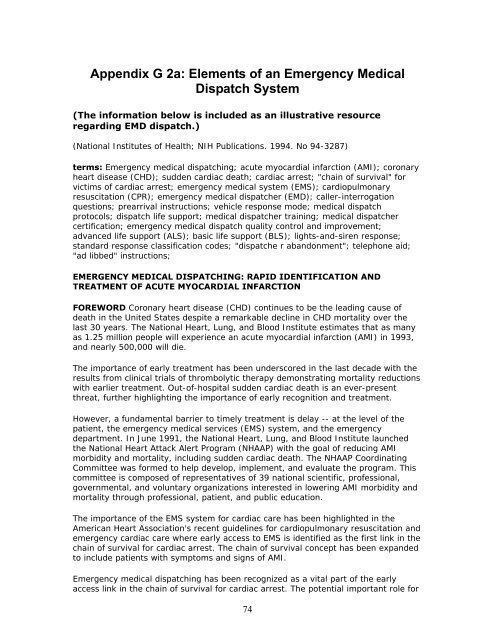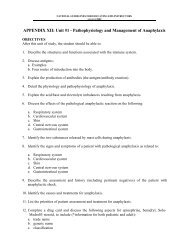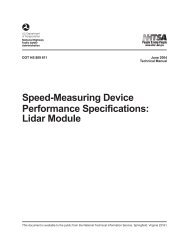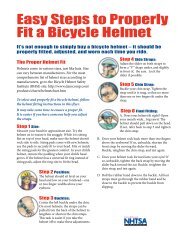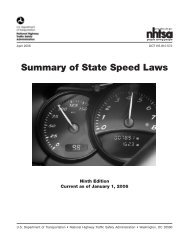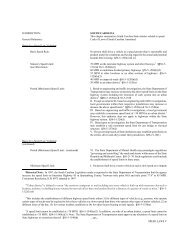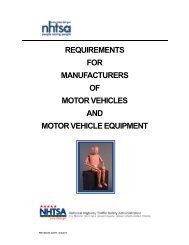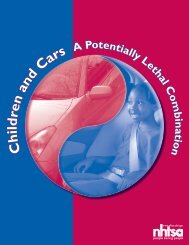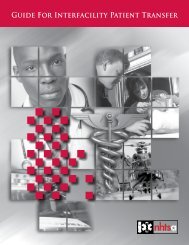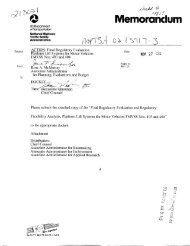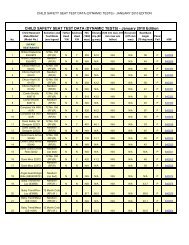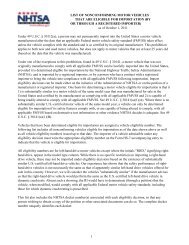Standard Practice for Emergency Medical Dispatch ... - NHTSA
Standard Practice for Emergency Medical Dispatch ... - NHTSA
Standard Practice for Emergency Medical Dispatch ... - NHTSA
Create successful ePaper yourself
Turn your PDF publications into a flip-book with our unique Google optimized e-Paper software.
Appendix G 2a: Elements of an <strong>Emergency</strong> <strong>Medical</strong><br />
<strong>Dispatch</strong> System<br />
(The in<strong>for</strong>mation below is included as an illustrative resource<br />
regarding EMD dispatch.)<br />
(National Institutes of Health; NIH Publications. 1994. No 94-3287)<br />
terms: <strong>Emergency</strong> medical dispatching; acute myocardial infarction (AMI); coronary<br />
heart disease (CHD); sudden cardiac death; cardiac arrest; "chain of survival" <strong>for</strong><br />
victims of cardiac arrest; emergency medical system (EMS); cardiopulmonary<br />
resuscitation (CPR); emergency medical dispatcher (EMD); caller-interrogation<br />
questions; prearrival instructions; vehicle response mode; medical dispatch<br />
protocols; dispatch life support; medical dispatcher training; medical dispatcher<br />
certification; emergency medical dispatch quality control and improvement;<br />
advanced life support (ALS); basic life support (BLS); lights-and-siren response;<br />
standard response classification codes; "dispatche r abandonment"; telephone aid;<br />
"ad libbed" instructions;<br />
EMERGENCY MEDICAL DISPATCHING: RAPID IDENTIFICATION AND<br />
TREATMENT OF ACUTE MYOCARDIAL INFARCTION<br />
FOREWORD Coronary heart disease (CHD) continues to be the leading cause of<br />
death in the United States despite a remarkable decline in CHD mortality over the<br />
last 30 years. The National Heart, Lung, and Blood Institute estimates that as many<br />
as 1.25 million people will experience an acute myocardial infarction (AMI) in 1993,<br />
and nearly 500,000 will die.<br />
The importance of early treatment has been underscored in the last decade with the<br />
results from clinical trials of thrombolytic therapy demonstrating mortality reductions<br />
with earlier treatment. Out-of-hospital sudden cardiac death is an ever-present<br />
threat, further highlighting the importance of early recognition and treatment.<br />
However, a fundamental barrier to timely treatment is delay -- at the level of the<br />
patient, the emergency medical services (EMS) system, and the emergency<br />
department. In June 1991, the National Heart, Lung, and Blood Institute launched<br />
the National Heart Attack Alert Program (NHAAP) with the goal of reducing AMI<br />
morbidity and mortality, including sudden cardiac death. The NHAAP Coordinating<br />
Committee was <strong>for</strong>med to help develop, implement, and evaluate the program. This<br />
committee is composed of representatives of 39 national scientific, professional,<br />
governmental, and voluntary organizations interested in lowering AMI morbidity and<br />
mortality through professional, patient, and public education.<br />
The importance of the EMS system <strong>for</strong> cardiac care has been highlighted in the<br />
American Heart Association's recent guidelines <strong>for</strong> cardiopulmonary resuscitation and<br />
emergency cardiac care where early access to EMS is identified as the first link in the<br />
chain of survival <strong>for</strong> cardiac arrest. The chain of survival concept has been expanded<br />
to include patients with symptoms and signs of AMI.<br />
<strong>Emergency</strong> medical dispatching has been recognized as a vital part of the early<br />
access link in the chain of survival <strong>for</strong> cardiac arrest. The potential important role <strong>for</strong><br />
74


